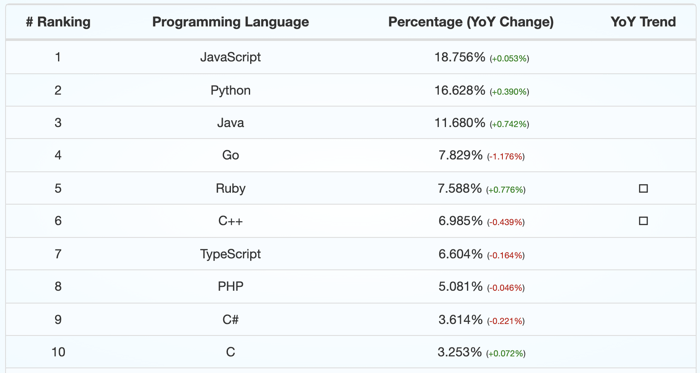Ruby vs Ruby on Rails: Top 6 Differences

These two terms are often confused by people. So we thought we’d write this guide to help make a clear distinction between Ruby vs Ruby on Rails.
In short, Ruby is more of a general purpose programming language, whereas Ruby on Rails is mainly applied to build database-driven web apps. Different companies use Ruby on Rails extensively in building various applications. Airbnb, GitHub, SlideShare, Dribbble, Bloomberg, CrunchBase, and Shopify (to name a few) have also trusted Ruby on Rails and used it in their applications.
In 2021, Ruby was the 5th most popular programming language, according to GitHub. To understand why this is such a popular application framework, and how Ruby fits in, it’s important to comprehend the differences between Ruby vs Ruby on Rails.
In this article, we’re going to go in-depth on what each tool does and explain the key differences. By the end of this article, you’ll have a greater understanding of the pros, cons, project use cases and inner workings of Ruby vs Ruby on Rails.
What is Ruby?
Ruby programming language was created by Yukihiro Matsumoto 1995, and is an open source, object oriented scripting language designed with simplicity as a core focus, and is known for its ability to build online applications quickly.
On the technical side, Ruby was written in C language and also supports multiple different platforms, like Windows, Mac, Linux, and Unix. Ruby’s simplicity and speed has made it a very popular choice amongst web application development professionals, and can also be used on the back end for data science and memory management purposes.

Source: GitHub
Ruby is generally thought of as being easier to understand than some other programming languages because it includes dynamic typing, which is more similar to spoken language than other coding languages. Here is the list:
- JRuby
- TruffleRuby
- Rubinius
- Mruby
- IronRuby
- MagLev
- Cardinal
What is Ruby on Rails?
Ruby on Rails is also an open source development tool, but it is not a scripted language. Rails is used primarily as a web application development framework and is based on the Model View Controller (MVC) architecture.
Model View Controller architecture can separate data structures from User Interface (UI) design, offering different views of data sets and enabling the fast design and deployment of complex projects, as well as ongoing maintenance and support.
Ruby on Rails consists of a number of different active modules, including:
- Active Record
- Active Support
- Active Model
- Active Resource
- Action Pack
- Action Mailer
This variety of modules provides for a flexible architecture.
Ruby and Ruby on Rails sound similar because Ruby on Rails was programmed in Ruby and then released to the public in 2005, 10 years after Ruby.
Ruby on Rails is mostly used for building web applications and server side scripting, but it can also be used to develop interface scripts. Ruby on Rails has become popular with developers for a number of reasons, including:
- Ability to write HTML code
- Easy database connectivity
- Effective app development
Rails helps to simplify the web development process because it removes the need for developers to write the same lines of code over and over again, encouraging the use of default convention over configuration (COC), which allows developers to write the code line once and move on.
Ruby and Ruby on Rails can be used in conjunction - many apps or projects make use of Ruby on Rails to enhance the effectiveness and capabilities of Ruby, making the programming language more efficient and powerful.
Now let’s take a look at the most important differences between Ruby and Ruby on Rails.
The most important differences between Ruby and Ruby on Rails
The differences between these two software tools can be broken down into five different ‘categories’: programming language vs web development framework, project use, development speed & script maintenance, syntax, and flexibility.
Each of these is an important consideration when you start your next project, so it;s important to know how they differ and the pros and cons for each.
1. A foundation vs an add-on
Ruby is an open source, object oriented general-purpose programming language, whereas Ruby on Rails is an open source web development framework.
As a programming language, Ruby has its own ‘syntax’ or language, as well as unique rules for its use and application. Programming languages are used to tell a computer what to do and how to execute that function.
Ruby on Rails, however, is not a programming language but a web application development framework. Open source frameworks use scripts written by a wide community of developers, but don’t have their own unique syntax or language - instead, Rails uses the Ruby programming language.
Essentially, a web application framework is used to help improve and enhance the capability of programming languages, which means that a Ruby on Rails developer needs to have some knowledge of the Ruby programming language in order to use Ruby on Rails for effective web applications development.
2. A foundation principle
Ruby is based on the principle of user interface design. Matsumoto claimed that the language was designed to increase a developer's productivity and to minimize work.
However, Ruby on Rails was developed on principle of of DRY (Don't Repeat Yourself) and COC (Convention over Configuration). DRY means that RoR can recover this information from the database based on the class name. COC means that the unconventional aspects of an application can be specified by developers.
3. Types of projects
As you might expect with different functionalities, Ruby and Ruby on Rails are often used for different types of projects.
While you can’t use Ruby on Rails without working knowledge of Ruby, there are still certain projects where it would be beneficial to use Ruby on Rails on top of Ruby, such as web app development projects, where Rails can help simplify code and speed up the overall development process.
It’s important to note that while you can develop web apps written in Ruby, Rails is preferable because it makes the process simpler and faster.

Ruby on Rails efficiency also means that it is a good option for the development of minimum viable product (MVP) and prototypes for building web applications.
Meanwhile, Ruby is better if you want to develop desktop applications, which Rails is not geared up to do because it involves server-side scripting which mainly runs on a web server.
3. Deploying time and script maintenance capabilities
Ruby was purposefully designed to be intuitive for its users, an attribute that makes it simpler and more powerful than other object oriented scripted programming languages.
In addition, this enhances the language’s development speed and improves script maintenance capabilities. The difference here is that while software development with Ruby is fast, development with Ruby on Rails is even quicker.
As we mentioned above, Ruby on Rails was built on the ‘convention over configuration’ principle. Deploying default conventions instead of customized configuration files can save a huge amount of time in the development process, as well as giving your developers more time to focus on the parts of the application that would really benefit from more custom configured features.

Since the majority of an app’s development does not require custom configuration files, it’s easy to see that big chunks of time can be saved using Rails compared to Ruby, and the use of default conventions makes maintenance easier.
4. Syntax
Another principle on which Ruby on Rails is founded is the ‘DRY’ principle: Don’t Repeat Yourself.
While Ruby has a simple syntax itself, making it easy to write and maintain, Ruby on Rails syntax simplifies the process even further, eliminating the need for coders to write repeat lines of code, saving time and making for a less cluttered script - this simply syntax further enhances the maintenance capabilities of Ruby on Rails.
Ruby uses a similar syntax to other programs like Perl and Python, whereas Ruby on Rails is similar to Phoenix in Elixir. Ruby includes a number of different syntax features such as, syntax flexibility, garbage collection, reliable typing, inheritance, overloading, exception handling, lexical closures, built-in support, iterators, variable scope, centralized management system, custom dispatch behavior, all of which are able to be implemented on different platforms.
5. Flexibility
As both tools are open source, they both have flexibility as a core feature. However, Rails makes a key enhancement on Ruby by allowing developers to include additional languages in their scripts, such as HTML, Java, CSS and XML code.
These options are not available to developers using Ruby on its own, which perhaps gives Ruby on Rails the edge in terms of flexibility.
Ruby on Rails’ flexible architecture allows developers to easily and dynamically develop web applications which truly express the initial design vision.
Ruby vs Ruby on Rails: Side-by-side comparison
As we can see, the history of Ruby and Ruby on Rails is intertwined. There would be no Rails without Ruby, but since Ruby on Rails was first designed in 2005, it has become more widely used as a result of the enhancements it makes on certain Ruby features and functions.
The amount of successful companies using Ruby on Rails for their own app development and UI design is testament to how powerful it can be.
However, we’ve also learned that while Ruby on Rails is slightly more flexible than Ruby in its syntax and speedier in development and dscript maintenance, it is more widely used as a web development framework, rather than for building desktop applications.
Now you know the key differences between Ruby vs Ruby on Rails, you can make a more informed decision the next time you decide to start a web app development project.




















.jpg?width=384&height=202&name=DSC_8539%20(1).jpg)

